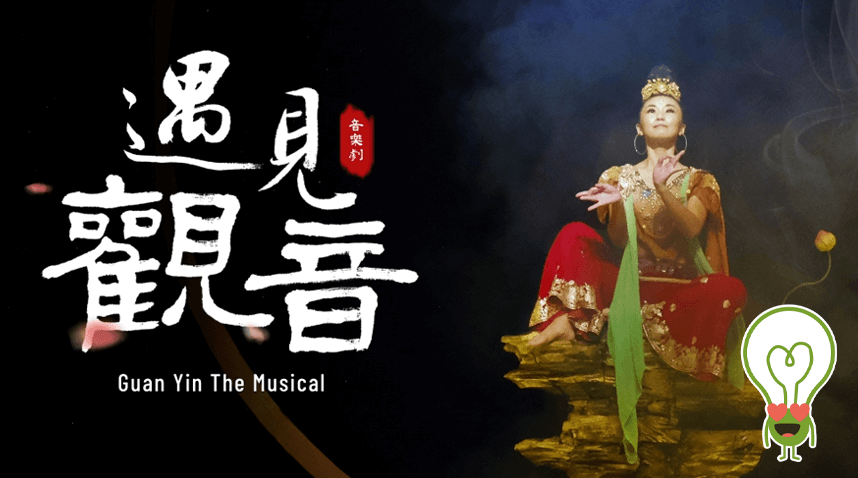Editor’s note: This review has been kindly sponsored by 地藏林 Di Zang Lin, organiser of《遇见观音》音乐剧 Guan Yin The Musical
TLDR: Ying Cong reviews the Guan Yin musical and explores the relevance of Guan Yin in today’s fast-paced and often tumultuous society.
“Guan Yin” is a name I hadn’t thought about in a long time. That’s why, as I cleared my head of work to prepare for the Guan Yin musical on Friday evening, my imagination stuttered.
Shifting my focus from the day-to-day challenges of business growth to the age-old tales of Guan Yin was like stepping from a bustling city into a tranquil ancient temple.
For the next three hours, Victoria Theatre would be my modern-day temple, a sacred space where these ancient tales would be retold.
A modern encounter
Like many millennials, my impression of Guan Yin is a distorted one, pieced together from fragments encountered in various temples and snatches of her story in movies and TV shows.
Guan Yin was a celestial figure featured in key moments of Journey to the West, a TV series I eagerly watched with my family over dinner in the early 2000s.
Other than that, my most light-hearted memory of Guan Yin was a scene in the 2002 movie, I Not Stupid, where the overzealous mother of an underperforming EM3 student prayed for her child’s academic success at the temple.
After eagerly stuffing some cash into the donation box, the temple staff informed her that as part of their digital transformation, the blessing papers for her son were now downloadable on guanyinma.com.
In various heartland Channel 8 dramas in Singapore, Guan Yin is the ultimate social safety net whom protagonists turn to for everything from financial to romantic help in their darkest moments.
My fiancée and I entered early and watched the audience stream in. It was, understandably, an older demographic – grandparents with their grandkids, groups of friends from various Buddhist groups, monastics associated with the musical producer at Dizanglin.
Out of insecurity of my patchy understanding of Guan Yin, I served myself a Wikipedia crash course on her origins. Like most figures with sustained history, the origin story is complicated and winding.
It turns out Guan Yin is the Chinese interpretation of the symbolic figure of Avalokiteshvara, who is an instantiation of the Bodhisattva. In Mahayana Buddhism, the Bodhisattva, out of compassion for all beings, chooses to remain in the cycle of samsara to alleviate their suffering.
From Royalty to Dhamma
Soon, the lights dimmed and the curtains drew. The live Chinese orchestra in the pits started playing, and we were greeted with an opening chant by a troupe of white-robed singers, tuned to a calming, angelic melody.
This ethereal singing is, happily, a fixture for the remainder of the show. The musical is split into 4 stories marking pivotal moments in Guan Yin’s life.
The first story describes her origin. Guan Yin was born as Princess Miao Shan. Somewhat reminiscent of Siddhartha’s growing up years, she came of age with scant attraction to the earthly allures of luxurious clothes and royal food, instead inclining heavily towards Dharma.
In a similar narrative twist, she rejected her father’s wish for her to marry royally, vowing instead to ordain. Her father was understandably enraged and punished her with menial chores, which she patiently endured. Finally, he relented, and she set off on her arduous path.
Through various sages, she learned of a vase up on a mountain that holds the key to her future. It turns out this was no Bukit Timah Hill, especially in the days before proper climbing gear. The treacherous uphill journey was infested with menacing beasts.
This was artfully depicted with evocative sand art projected onto the backdrop. With a brief wave of the artist’s hands and some dexterous tracing, the sand quickly outlined the dripping viciousness of a lion, a tiger and a viper.
Another sweep later, we saw the valiant elephant who rode in to defend her. When she finally found the sage with the vase, she pleadingly asked when she would be enlightened. The answer returned resoundingly – there are too many beings suffering for her to escape from this world.
Guan Yin’s Market Teaching
The second act is a much more light-hearted tale set in a bustling village market. She came this time with a basket containing live fish, intending to inculcate the lessons of compassion.
The villagers, tempted by the fish, wanted to buy it for food. Taking this as the spark for her teaching, she implored them to consider the pains of the fish when it dies for their plates.
Although somewhat chastened, the village men remained undeterred and expressed a desire to marry her. Smilingly but unfazed, she said she can only pick one – the one who can memorise all the chants she issued to them.
After a few rounds of increasingly longer brain-breaking chants, where initially overconfident contenders dropped like flies, an earnest and affable fisherman emerged as her groom.
Yet, while the villagers basked in the celebrations of the wedding, they found her dead, and decomposing faster than usual. Among this confusing turn of events, a monk appeared, and enlightened the groom that she was Guan Yin incarnated, and has come to share the teachings of compassion with them through the chants.
His duty from then on was to spread the teachings contained in the chants he had memorised.
War, death, and compassion
The third story opened with a chilling backdrop. In this story, the common folks were wilfully slaughtered in a war between nations, and the spirits of the innocent dead lingered in hatred, pain and self-pity.
Cast in a dim red light, the dancers writhed and howled in visceral agony. I could feel my fiancée tensing up in her seat. Also sensing the suffering thick in the air, Guan Yin manifested as a monastic, sat by the river near the dead, and chanted non-stop for 49 days to transcend the trapped spirits to a good rebirth.
The relief was palpable throughout the theatre as the howling ghosts calmed down, prostrated with profuse gratitude and spirited away peacefully, light as air.
Guan Yin Transcends Time
The last story connected Guan Yin’s story to the present. It tells of a Japanese monk who visited the Guan Yin statue in Wu Tai Shan. In a moment of desperate folly, he nabbed the statue, intending to invite Guan Yin home to palliate his mother’s ailments.
He then set off on a small boat into the ocean towards Japan. The seas were calm at first. The dancers who depicted the waves pulsed steadily with billowing white cloths.
Yet, with a thunderous strike, the waves leapt into wild rage, trapping him to the shores of an island.
Taking it as a sign from Guan Yin, he disembarked, and settled down. This island eventually became the site of the main Guan Yin temple at Pu Tuo Shan, which exists till today.
Guan Yin in TikTok land
As the curtains drew to a close, the essence of the stories lingered in my mind, weaving a tapestry where compassion stood as the timeless, yet often overlooked, thread.
In today’s world, where the loud howls of status, power, and wealth dominate, the gentle murmurs of compassion exemplified by Guan Yin stand in stark contrast, offering a much-needed respite.
It made me question the hierarchy of values I had unconsciously prioritised – where achievement and status are the celebrated protagonists, while kindness and compassion often find themselves relegated to the background.
Looking at our daily headlines and the trends on platforms like TikTok, it is striking how rarely compassion, as opposed to controversy or sensationalism, takes the spotlight.
The irony is poignant: we are often taught to be kind, yet society rewards us for worldly accomplishments. It is only in moments of burnout, when a sense of meaninglessness begins to shadow the relentless chase in our careers, that the whisper reaches a crescendo as a clarion call – compassion is not just necessary for a healthy society, but also a healthy mind.
Despite her selfless giving to the multitudes of suffering beings, Guan Yin herself has not once lost her inner sanctuary of peace.
Reflecting on this, the name “Guan Yin,” which had long been absent from my thoughts, now takes on a new significance. As I stepped out of the modern-day temple of Victoria Theatre, I realised that the age-old tales of Guan Yin are more relevant today than ever.
Wise Steps
- Practice Daily Compassion: Incorporate small acts of kindness in your daily life, fostering a compassionate mindset inspired by Guan Yin’s teachings.
- Reflect on Values: Evaluate personal priorities, questioning societal norms, and consider integrating compassion as a fundamental value in decision-making.
- Share Compassion: Spread awareness by sharing the article or discussing it with friends and family, encouraging conversations about the importance of compassion in today’s world.


